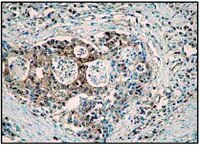Mitochondrial-nuclear communication by prohibitin shuttling under oxidative stress.
Srinivas R Sripathi,Weilue He,Cameron L Atkinson,Joseph J Smith,Zhicong Liu,Beth M Elledge,Wan Jin Jahng
Biochemistry
50
2010
Mostrar resumen
Mitochondrial-nuclear communication is critical for maintaining mitochondrial activity under stress conditions. Adaptation of the mitochondrial-nuclear network to changes in the intracellular oxidation and reduction milieu is critical for the survival of retinal and retinal pigment epithelial (RPE) cells, in relation to their high oxygen demand and rapid metabolism. However, the generation and transmission of the mitochondrial signal to the nucleus remain elusive. Previously, our in vivo study revealed that prohibitin is upregulated in the retina, but downregulated in RPE cells in the aging and diabetic model. In this study, the functional role of prohibitin in the retina and RPE cells was examined using biochemical methods, including a lipid binding assay, two-dimensional gel electrophoresis, immunocytochemistry, Western blotting, and a knockdown approach. Protein depletion by siRNA characterized prohibitin as an anti-apoptotic molecule in mitochondria, while the lipid binding assay demonstrated subcellular communication between mitochondria and the nucleus under oxidative stress. The changes in the expression and localization of mitochondrial prohibitin triggered by reactive oxygen species are crucial for mitochondrial integrity. We propose that prohibitin shuttles between mitochondria and the nucleus as an anti-apoptotic molecule and a transcriptional regulator in a stress environment in the retina and RPE cells. | 21879722
 |
Lack of pathology in a triple transgenic mouse model of Alzheimer's disease after overexpression of the anti-apoptotic protein Bcl-2.
Rohn, TT; Vyas, V; Hernandez-Estrada, T; Nichol, KE; Christie, LA; Head, E
The Journal of neuroscience : the official journal of the Society for Neuroscience
28
3051-9
2008
Mostrar resumen
Alzheimer's disease (AD) is characterized by the accumulation of plaques containing beta-amyloid (Abeta) and neurofibrillary tangles (NFTs) consisting of modified tau. Although Abeta deposition is thought to precede the formation of NFTs in AD, the molecular steps connecting these two pathologies is not known. Previous studies have suggested that caspase activation plays an important role in promoting the pathology associated with AD. To further understand the contribution of caspases in disease progression, a triple transgenic Alzheimer's mouse model overexpressing the anti-apoptotic protein Bcl-2 was generated. Here we show that overexpression of Bcl-2 limited caspase-9 activation and reduced the caspase cleavage of tau. Moreover, overexpression of Bcl-2 attenuated the processing of APP (amyloid precursor protein) and tau and reduced the number of NFTs and extracellular deposits of Abeta associated with these animals. In addition, overexpression of Bcl-2 in 3xTg-AD mice improved place recognition memory. These findings suggest that the activation of apoptotic pathways may be an early event in AD and contributes to the pathological processes that promote the disease mechanisms underlying AD. | 18354008
 |
Molecular determinants of the caspase-promoting activity of Smac/DIABLO and its role in the death receptor pathway.
Srinivasula, S M, et al.
J. Biol. Chem., 275: 36152-7 (2000)
1999
Mostrar resumen
Smac/DIABLO is a mitochondrial protein that is released along with cytochrome c during apoptosis and promotes cytochrome c-dependent caspase activation by neutralizing inhibitor of apoptosis proteins (IAPs). We provide evidence that Smac/DIABLO functions at the levels of both the Apaf-1-caspase-9 apoptosome and effector caspases. The N terminus of Smac/DIABLO is absolutely required for its ability to interact with the baculovirus IAP repeat (BIR3) of XIAP and to promote cytochrome c-dependent caspase activation. However, it is less critical for its ability to interact with BIR1/BIR2 of XIAP and to promote the activity of the effector caspases. Consistent with the ability of Smac/DIABLO to function at the level of the effector caspases, expression of a cytosolic Smac/DIABLO in Type II cells allowed TRAIL to bypass Bcl-xL inhibition of death receptor-induced apoptosis. Combined, these data suggest that Smac/DIABLO plays a critical role in neutralizing IAP inhibition of the effector caspases in the death receptor pathway of Type II cells. | 10950947
 |
The receptor for the cytotoxic ligand TRAIL.
Pan, G, et al.
Science, 276: 111-3 (1997)
1997
Mostrar resumen
TRAIL (also known as Apo-2L) is a member of the tumor necrosis factor (TNF) ligand family that rapidly induces apoptosis in a variety of transformed cell lines. The human receptor for TRAIL was found to be an undescribed member of the TNF-receptor family (designated death receptor-4, DR4) that contains a cytoplasmic "death domain" capable of engaging the cell suicide apparatus but not the nuclear factor kappa B pathway in the system studied. Unlike Fas, TNFR-1, and DR3, DR4 could not use FADD to transmit the death signal, suggesting the use of distinct proximal signaling machinery. Thus, the DR4-TRAIL axis defines another receptor-ligand pair involved in regulating cell suicide and tissue homeostasis. | 9082980
 |













